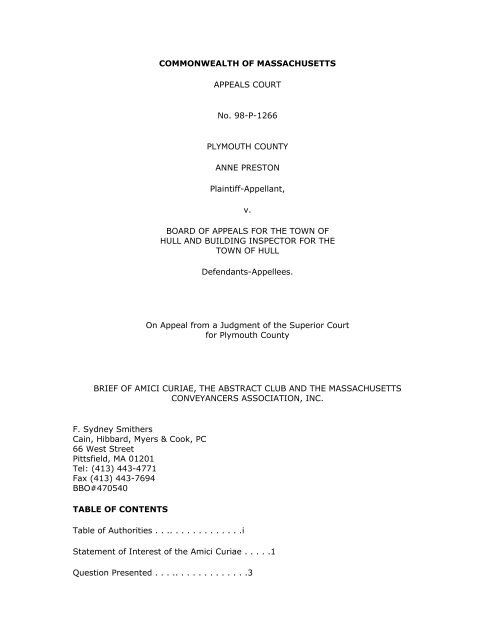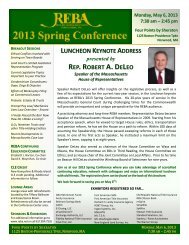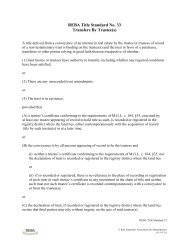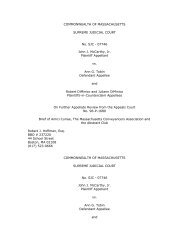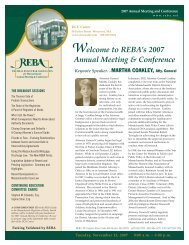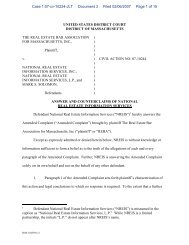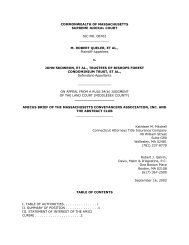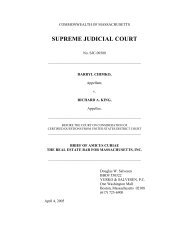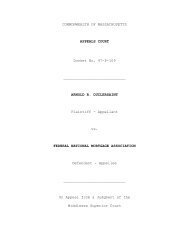Anne Preston v. Board of Appeals for the Town of Hull and Building ...
Anne Preston v. Board of Appeals for the Town of Hull and Building ...
Anne Preston v. Board of Appeals for the Town of Hull and Building ...
You also want an ePaper? Increase the reach of your titles
YUMPU automatically turns print PDFs into web optimized ePapers that Google loves.
COMMONWEALTH OF MASSACHUSETTS<br />
APPEALS COURT<br />
No. 98-P-1266<br />
PLYMOUTH COUNTY<br />
ANNE PRESTON<br />
Plaintiff-Appellant,<br />
v.<br />
BOARD OF APPEALS FOR THE TOWN OF<br />
HULL AND BUILDING INSPECTOR FOR THE<br />
TOWN OF HULL<br />
Defendants-Appellees.<br />
On Appeal from a Judgment <strong>of</strong> <strong>the</strong> Superior Court<br />
<strong>for</strong> Plymouth County<br />
BRIEF OF AMICI CURIAE, THE ABSTRACT CLUB AND THE MASSACHUSETTS<br />
CONVEYANCERS ASSOCIATION, INC.<br />
F. Sydney Smi<strong>the</strong>rs<br />
Cain, Hibbard, Myers & Cook, PC<br />
66 West Street<br />
Pittsfield, MA 01201<br />
Tel: (413) 443-4771<br />
Fax (413) 443-7694<br />
BBO#470540<br />
TABLE OF CONTENTS<br />
Table <strong>of</strong> Authorities . . .. . . . . . . . . . . . .i<br />
Statement <strong>of</strong> Interest <strong>of</strong> <strong>the</strong> Amici Curiae . . . . .1<br />
Question Presented . . . .. . . . . . . . . . . . .3
Statement <strong>of</strong> <strong>the</strong> Case . . . . . . . . . . . . . . .4<br />
Prior Proceedings . . . . . . . . . . . . . . 4<br />
Facts . . . . . . . . . . . . . . . . . . . . 4<br />
Summary <strong>of</strong> Argument. . . . . . . . . . . . . . . .4<br />
Argument . . . . . . . . . . . . . . . . . . . . .5<br />
Conclusion .. . . . . . . . . . . . . . . . . . . .8<br />
TABLE OF AUTHORITIES<br />
CASES PAGES<br />
Adamowicz v. Ipswich, 395 Mass. 757 (1985) 6<br />
Carci<strong>of</strong>i v. <strong>Board</strong> <strong>of</strong> Appeal <strong>of</strong> Billerica, 7<br />
22 Mass. App. Ct. 926 (1986)<br />
Dowling v. <strong>Board</strong> <strong>of</strong> Health <strong>of</strong> Chilmark, 6<br />
28 Mass. App. Ct. 547 (1990)<br />
STATUTES<br />
G.L. c. 40A, § 6 3, 4, 5, 6, 7, 8, 9<br />
OTHER AUTHORITIES<br />
Bobrowski, H<strong>and</strong>book <strong>of</strong> Massachusetts L<strong>and</strong> 8<br />
Use <strong>and</strong> Planning Law (1993 ed. <strong>and</strong> Supp. 1998)<br />
Schmidt, L<strong>and</strong> Use Manager, EOCD (Aug. 1986) 8<br />
STATEMENT OF INTEREST OF THE AMICI CURIAE<br />
The Abstract Club is a voluntary association. It has been in existence <strong>for</strong> over 100<br />
years. It is limited by its by-laws to 100 members. Most <strong>of</strong> its members practice in<br />
<strong>the</strong> City <strong>of</strong> Boston or in <strong>the</strong> Boston suburbs; a few practice in o<strong>the</strong>r cities <strong>of</strong> <strong>the</strong><br />
Commonwealth. Almost all <strong>of</strong> <strong>the</strong>m practice exclusively, or nearly so, in <strong>the</strong> area <strong>of</strong><br />
real estate. An intimate <strong>and</strong> thorough knowledge <strong>of</strong> <strong>the</strong> zoning law <strong>of</strong> <strong>the</strong><br />
Commonwealth <strong>and</strong> municipality in which a parcel <strong>of</strong> real estate is located is vital to<br />
<strong>the</strong> real estate practitioner's ability to advise a client as to <strong>the</strong> use to which a parcel<br />
<strong>of</strong> real estate may be put. Of necessity, real estate practitioners are <strong>the</strong>re<strong>for</strong>e also<br />
zoning lawyers.<br />
The Massachusetts Conveyancers Association, Inc. ("MCAI") is a non-pr<strong>of</strong>it
corporation. It has also been in existence <strong>for</strong> over 100 years. It has over 2,900<br />
members, who practice in cities <strong>and</strong> towns throughout <strong>the</strong> Commonwealth. It is <strong>the</strong><br />
largest specialty bar in <strong>the</strong> Commonwealth. Many <strong>of</strong> its members practice extensively<br />
in o<strong>the</strong>r areas, but all <strong>of</strong> <strong>the</strong>m practice in <strong>the</strong> real estate area to such a degree as to<br />
motivate <strong>the</strong>m to belong to MCAI. Through its meetings, educational programs,<br />
publications, <strong>and</strong> work <strong>of</strong> its committees , <strong>the</strong>y can keep abreast <strong>of</strong> developments in<br />
<strong>the</strong> field <strong>of</strong> real estate law <strong>and</strong> practice <strong>and</strong> share in <strong>the</strong> ef<strong>for</strong>t to improve such<br />
practice.<br />
Both <strong>the</strong> Abstract Club <strong>and</strong> MCAI work toward <strong>the</strong> improvement <strong>of</strong> real estate law<br />
<strong>and</strong> practice through <strong>the</strong>ir educational programs, <strong>the</strong> promulgation <strong>of</strong> title st<strong>and</strong>ards,<br />
practice st<strong>and</strong>ards, ethical st<strong>and</strong>ards, <strong>and</strong> real estate <strong>for</strong>ms. In <strong>the</strong> field <strong>of</strong><br />
legislation, <strong>the</strong>y draft <strong>and</strong> sponsor legislation designed to deal with problems which<br />
arise in real estate law <strong>and</strong> practice <strong>and</strong> which can be cured or alleviated by<br />
appropriate legislation <strong>and</strong> <strong>the</strong>y support or oppose legislation drafted <strong>and</strong> sponsored<br />
by o<strong>the</strong>rs.<br />
The Amicus Committee is a joint committee <strong>of</strong> <strong>the</strong> two organizations. Its members<br />
are currently sixteen real estate <strong>and</strong> zoning lawyers with many years <strong>of</strong> experience.<br />
They decide whe<strong>the</strong>r cases from trial courts or appellate courts are <strong>of</strong> enough<br />
significance <strong>and</strong> interest to <strong>the</strong> real estate bar to justify <strong>the</strong> preparation <strong>and</strong> filing <strong>of</strong><br />
amicus briefs. From time to time <strong>the</strong>y also file briefs when requested to do so by <strong>the</strong><br />
<strong>Appeals</strong> Court. All <strong>of</strong> <strong>the</strong>ir briefs, whe<strong>the</strong>r assigned to one or two lawyers to prepare,<br />
are reviewed by o<strong>the</strong>rs <strong>of</strong> <strong>the</strong> Committee.<br />
The case at bar presents a fundamental zoning question frequently faced by <strong>the</strong><br />
members <strong>of</strong> <strong>the</strong> real estate bar <strong>and</strong> <strong>the</strong>ir clients: may two adjacent lots, owned in<br />
common in <strong>the</strong> circumstances presented here, each now be built upon, or must <strong>the</strong>y<br />
be merged <strong>and</strong> result in only one building site? The answer to this question, <strong>and</strong> <strong>the</strong><br />
underlying policy in<strong>for</strong>ming <strong>the</strong> answer, is <strong>of</strong> great concern to <strong>the</strong> members <strong>of</strong> both<br />
organizations; it is hoped <strong>the</strong>ir views on <strong>the</strong> question may be <strong>of</strong> assistance to <strong>the</strong><br />
Court.<br />
QUESTION PRESENTED<br />
Whe<strong>the</strong>r <strong>the</strong> plain language <strong>of</strong> G.L. c. 40A, §6, 4, First Sentence requires that each<br />
<strong>of</strong> two non-con<strong>for</strong>ming lots not held in common ownership at <strong>the</strong> time <strong>of</strong> adoption <strong>of</strong><br />
higher zoning requirements but now held in common ownership are now zoning legal<br />
one or two-family residential building lots provided each contains 5,000 square feet<br />
or more <strong>of</strong> area <strong>and</strong> has 50 feet or more <strong>of</strong> frontage?<br />
STATEMENT OF THE CASE<br />
Prior Proceedings<br />
These amici adopt <strong>the</strong> Appellant's Statement <strong>of</strong> <strong>the</strong> Case.<br />
Facts
These amici adopt <strong>the</strong> Appellant's Statement <strong>of</strong> Facts as exp<strong>and</strong>ed by <strong>the</strong> Appellees.<br />
SUMMARY OF ARGUMENT<br />
In light <strong>of</strong> <strong>the</strong> Legislature's prior opportunity to legislate <strong>the</strong> merger <strong>of</strong> subst<strong>and</strong>ard<br />
gr<strong>and</strong>fa<strong>the</strong>red lots if subsequently held in common ownership, <strong>and</strong> its failure to do<br />
so, <strong>the</strong> plain words <strong>of</strong> G.L. c. 40A, §6 require that each <strong>of</strong> Lots 22 <strong>and</strong> 24 is now a<br />
separate legal building lot. Policy arguments favoring merger <strong>and</strong> <strong>the</strong> elimination <strong>of</strong><br />
subst<strong>and</strong>ard lots are more appropriately addressed to <strong>the</strong> Legislature.<br />
ARGUMENT<br />
It is not disputed that prior to 1969 each <strong>of</strong> Lots 22 <strong>and</strong> 24 contained in excess <strong>of</strong><br />
5,000 square feet <strong>of</strong> area, had 50 feet <strong>of</strong> frontage, <strong>and</strong> con<strong>for</strong>med to <strong>the</strong> <strong>the</strong>n<br />
dimensional requirements <strong>of</strong> <strong>the</strong> <strong>Hull</strong> Zoning By-Law. It is not disputed that each lot<br />
was held in separate ownership in 1969 when <strong>the</strong> <strong>Hull</strong> Zoning By-Law was amended<br />
to require 6,500 square feet <strong>of</strong> area <strong>and</strong> 50 feet <strong>of</strong> frontage. It is not disputed that<br />
each lot continued to be held in separate ownership in 1978 when <strong>the</strong> present<br />
dimensional requirements <strong>of</strong> 12,000 square feet <strong>of</strong> area <strong>and</strong> 75 feet <strong>of</strong> frontage,<br />
respectively, were adopted. Lots 22 <strong>and</strong> 24 first came into common ownership, in <strong>the</strong><br />
Appellant, in 1987.<br />
The plain words <strong>of</strong> G.L. c. 40A, §6, 4, First Sentence preclude <strong>the</strong> application <strong>of</strong> <strong>the</strong><br />
higher dimensional requirements to Lot 22 <strong>and</strong> 24 notwithst<strong>and</strong>ing <strong>the</strong>ir present<br />
common ownership.<br />
O<strong>the</strong>r than defining <strong>the</strong> term "Non-Con<strong>for</strong>ming Lot" as "[a] lot that does not con<strong>for</strong>m<br />
to <strong>the</strong> regulations prescribed by this by-law <strong>for</strong> <strong>the</strong> district in which it is located"<br />
(Appellees' Supplemental Appendix S.A. 11), <strong>the</strong> <strong>Hull</strong> Zoning By-Law is silent on <strong>the</strong><br />
issue <strong>of</strong> non-con<strong>for</strong>ming lots <strong>and</strong> thus sole reliance is to be had to G.L. c. 40A, §6.<br />
G.L. c. 40A, §6, 4, First Sentence provides:<br />
"Any increase in area, frontage . . . requirements <strong>of</strong> a zoning by-law shall not apply<br />
to a lot <strong>for</strong> single <strong>and</strong> two-family residential use which at <strong>the</strong> time <strong>of</strong> recording [a<br />
deed <strong>of</strong> such lot] . . . was not held in common ownership with any adjoining l<strong>and</strong>,<br />
con<strong>for</strong>med to <strong>the</strong>n existing requirements <strong>and</strong> had less than <strong>the</strong> proposed<br />
requirement but at least five thous<strong>and</strong> square feet <strong>of</strong> area <strong>and</strong> fifty feet <strong>of</strong> frontage."<br />
G.L. c. 40, §6 (emphasis added). The purpose <strong>of</strong> c. 40A, §6 is "to protect a once<br />
valid residential lot from being rendered unbuildable by <strong>the</strong> enactment <strong>of</strong> more<br />
stringent zoning requirements." Dowling v. <strong>Board</strong> <strong>of</strong> Health <strong>of</strong> Chilmark, 28 Mass.<br />
App. Ct. 547, 550 (1990).<br />
As it is "<strong>the</strong> status <strong>of</strong> <strong>the</strong> lot immediately prior to <strong>the</strong> zoning change," which<br />
determines whe<strong>the</strong>r <strong>the</strong> lot was a once valid building lot, <strong>the</strong> "compliance <strong>of</strong> a lot<br />
with <strong>the</strong> common ownership requirement in <strong>the</strong> relevant sentence <strong>of</strong> G.L. c. 40A, §6,<br />
is determined by looking at <strong>the</strong> most recent instrument <strong>of</strong> record prior to <strong>the</strong><br />
effective date <strong>of</strong> <strong>the</strong> zoning change from which <strong>the</strong> exemption is sought." Adamowicz<br />
v. Ipswich, 395 Mass. 757, 762, (1985). Looking at <strong>the</strong> status <strong>of</strong> Lots 22 <strong>and</strong> 24 in<br />
1969 reveals <strong>the</strong>y con<strong>for</strong>med to <strong>the</strong>n existing zoning requirements, were held in<br />
separate ownership at <strong>the</strong> time <strong>of</strong> each adoption <strong>of</strong> higher requirements <strong>and</strong> thus,<br />
<strong>the</strong> higher frontage <strong>and</strong> area requirements shall not apply. G.L. c. 40A, §6.
In Carci<strong>of</strong>i v. <strong>Board</strong> <strong>of</strong> <strong>Appeals</strong> <strong>of</strong> Billerica, <strong>the</strong> <strong>Appeals</strong> Court held that a<br />
"gr<strong>and</strong>fa<strong>the</strong>red" lot was entitled to a building permit notwithst<strong>and</strong>ing that it had been<br />
subsequently held in common ownership with ano<strong>the</strong>r subst<strong>and</strong>ard lot <strong>for</strong> a<br />
substantial period <strong>of</strong> time after by-law amendments making each lot subst<strong>and</strong>ard as<br />
to frontage were adopted. Carci<strong>of</strong>i v. <strong>Board</strong> <strong>of</strong> <strong>Appeals</strong> <strong>of</strong> Billerica, 22 Mass. App. Ct.<br />
926 (1986).<br />
The plain words <strong>of</strong> <strong>the</strong> statute must prevail over <strong>the</strong> policy considerations urged by<br />
<strong>the</strong> Appellee <strong>and</strong> relied upon by <strong>the</strong> lower court. If <strong>the</strong> policy <strong>of</strong> merger <strong>of</strong><br />
subst<strong>and</strong>ard lots is to become <strong>the</strong> law <strong>of</strong> <strong>the</strong> Commonwealth, that action must be left<br />
to <strong>the</strong> General Court.<br />
Prior to <strong>the</strong> adoption <strong>of</strong> <strong>the</strong> present G.L. c. 40A, §6 as part <strong>of</strong> 1975 Mass. Acts 808,<br />
<strong>the</strong> Department <strong>of</strong> Community Affairs had urged that:<br />
"Lots held in separate ownership at <strong>the</strong> time <strong>of</strong> <strong>the</strong> zoning change would be subject<br />
to an absolute freeze with respect to residential use, if not subsequently held in<br />
common ownership with that <strong>of</strong> adjoining l<strong>and</strong> located in <strong>the</strong> same residential<br />
district."<br />
1972 House Doc. No. 5009, at 42. The <strong>for</strong>egoing recommendation was consistently<br />
put be<strong>for</strong>e <strong>the</strong> Legislature: 1973 House Doc. No. 6200 at 22; 1973 House Doc. No.<br />
7227 at 19; 1974 House Doc. No. 2522 at 24. Ultimately, however, <strong>the</strong> merger<br />
requirement <strong>for</strong> lots subsequently held in common ownership was not included in c.<br />
40A, §6. Bobrowski, H<strong>and</strong>book <strong>of</strong> Massachusetts L<strong>and</strong> Use <strong>and</strong> Planning Law, §5.3.1<br />
(1993 ed., Supp. 1998). One commentator has stated:<br />
"It appears that <strong>the</strong> Legislature considered <strong>and</strong> rejected language which would have<br />
required <strong>the</strong> merger <strong>of</strong> separate lots if subsequently held in common ownership after<br />
<strong>the</strong> effective date <strong>of</strong> <strong>the</strong> by-law."<br />
Schmidt, L<strong>and</strong> Use Manager, EOCD Vol. 3, Ed. No. 6, Aug. 1986, p 3.<br />
Strong policy arguments can be, <strong>and</strong> have been, advanced as to why subst<strong>and</strong>ard<br />
lots, once "gr<strong>and</strong>fa<strong>the</strong>red" but later held in common ownership, should be merged<br />
(Appellees' Brief at 14, 15-16), but such arguments should be pressed upon <strong>the</strong><br />
Legislature which, having once considered <strong>and</strong> rejected <strong>the</strong> doctrine <strong>of</strong> merger, is <strong>the</strong><br />
only proper body to effectuate this change in <strong>the</strong> law.<br />
CONCLUSION<br />
The General Court substantially rewrote <strong>the</strong> Zoning Enabling Act in adopting 1975<br />
Mass. Acts 808, appearing as G.L. c. 40A. The Legislature considered, but did not<br />
adopt, a recommendation which would have required merger <strong>of</strong> subst<strong>and</strong>ard<br />
adjacent lots subsequently held in common as in this case. In light <strong>of</strong> such history,<br />
<strong>the</strong> clear m<strong>and</strong>ate <strong>of</strong> G.L. c. 40A, §6, 4, First Sentence is that Lots 22 <strong>and</strong> 24, having<br />
been in separate ownership at <strong>the</strong> time <strong>of</strong> adoption <strong>of</strong> <strong>the</strong> higher requirements, were<br />
<strong>the</strong>n, <strong>and</strong> are now, two separate legal building lots. If <strong>the</strong> perceived planning<br />
benefits <strong>of</strong> elimination <strong>of</strong> subst<strong>and</strong>ard lots is to be achieved, it is a question <strong>for</strong><br />
consideration <strong>and</strong> enactment by <strong>the</strong> General Court by a simple change to Section 6.<br />
This case should be rem<strong>and</strong>ed to <strong>the</strong> <strong>Hull</strong> <strong>Board</strong> <strong>of</strong> <strong>Appeals</strong> with instructions to<br />
fur<strong>the</strong>r consider <strong>Preston</strong>'s appeal, in light <strong>of</strong> <strong>the</strong> Court's decision.
Respectfully Submitted<br />
F. Sydney Smi<strong>the</strong>rs<br />
CAIN, HIBBARD, MYERS & COOK, PC<br />
66 West Street<br />
Pittsfield, MA 01201<br />
Tel: (413) 443-4771<br />
Fax: (413) 443-7694<br />
BB0#470540<br />
CERTIFICATE OF SERVICE<br />
I, F. SYDNEY SMITHERS, hereby certify that I have today sent, by first class mail, a<br />
copy <strong>of</strong> <strong>the</strong> <strong>for</strong>egoing motion to counsel <strong>for</strong> Appellant Ann M. <strong>Preston</strong> <strong>and</strong> Appellees<br />
Joseph L. Duffy, Jr., et al:<br />
APPELLANT: Walter L. Sullivan, Esquire<br />
Sullivan & Sullivan, P.C.<br />
80 Washington Street, Suite No.7<br />
Norwell, MA 02061<br />
APPELLEES:<br />
TOWN OF HULL: James Lampke, Esquire<br />
<strong>Town</strong> Counsel<br />
<strong>Town</strong> <strong>of</strong> <strong>Hull</strong>-Municipal <strong>Building</strong><br />
<strong>Hull</strong>, MA 02045<br />
COMMONWEALTH OF MASSACHUSETTS<br />
APPEALS COURT<br />
No. 98-P-1266<br />
PLYMOUTH COUNTY<br />
ANNE PRESTON<br />
Plaintiff-Appellant,<br />
v.<br />
BOARD OF APPEALS FOR THE TOWN OF<br />
HULL AND BUILDING INSPECTOR FOR THE<br />
TOWN OF HULL
Defendants-Appellees.<br />
On Appeal from a Judgment <strong>of</strong> <strong>the</strong> Superior Court <strong>for</strong> Plymouth County<br />
BRIEF OF AMICI CURIAE, THE ABSTRACT CLUB AND THE MASSACHUSETTS<br />
CONVEYANCERS ASSOCIATION, INC.<br />
F. Sydney Smi<strong>the</strong>rs<br />
Cain, Hibbard, Myers & Cook, PC<br />
66 West Street<br />
Pittsfield, MA 01201<br />
Tel: (413) 443-4771<br />
Fax (413) 443-7694<br />
BBO#470540


